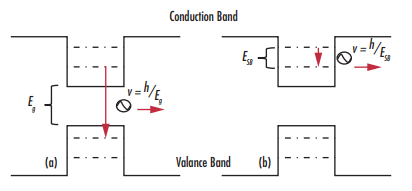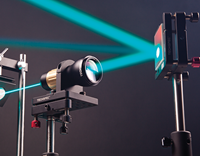Common Laser Types
This is Section 3.1 of the Laser Optics Resource Guide.
Lasers are often classified by the gain medium used for light amplification. Common gain media types are gas, semiconductor (diode), and solid state. The key parameters of laser systems can be found in our Key Parameters of a Laser System application note.
Overview of Common Industrial Lasers
Figure 1 shows 23 of the most common lasers and their wavelengths, modes of operation, and typical gain media.

Figure 1: Common commercial lasers with typical modes of operation and gain media, where CW stands for continuous wave. 2,3
Gas lasers, such as helium neon (HeNe), are often used for metrology applications due to their high beam quality and long coherence length. Other types of gas lasers, such as carbon dioxide (CO2) lasers, are frequently used for materials processing because they can reach exceptionally high average powers.
Diode lasers contain a semiconductor p-n junction as the gain medium. They tend to have the highest power-to-cost ratio and benefit from high power conversion efficiency, high quantum efficiency, and a wide range of available wavelengths. Diode lasers are utilized in many applications including telecommunication, materials processing, bar code scanning, medical lasers, and LIDAR systems.
Solid state lasers utilize crystals or glass materials doped with transition metal or rare earth ions. They are often utilized for high power applications, such as material processing and medical lasers, because they can reach some of the highest peak powers out of all commercially available lasers.3 However, it is harder to cool solid state gain media, which limits repetition rate and average power.
Two special cases of solid state lasers are quantum cascade lasers (QCLs) and interband cascade lasers (ICLs). QCLs are tunable, semiconductor, mid-IR lasers that operate through intersubband transitions in alternating layers of thin semiconductor layers, or “wells”. Intersubband transitions are excitations between quantized energy states within the conduction band (Figure 2). Because of the extremely small size of the wells, quantum effects take over and the emission wavelength shifts as a function of well thickness. QCLs can produce high power at long wavelengths through the combination of both quantum and cascade effects. Most commercially-available QCLs tend to have wavelengths around 4-11μm, but the extremes of commercially available QCLs have wavelengths ranging from 2.63-150μm.4,5,6
ICLs are similar to QCLs in that they use layered semiconductor structures and quantum wells for mid-IR lasing, but photons are generated through interband rather than intrasubband transitions (Figure 2). They are able to operate with lower input powers than QCLs.

Figure 2: Comparison of (a) interband and (b) intersubband transitions in a cascade laser
Lasers from Edmund Optics®

Edmund Optics offers a wide range of laser sources as well as laser optics, safety equipment, and measurement devices.
VIEW LASERS NOW
References
- Paschotta, Rüdiger. Encyclopedia of Laser Physics and Technology, RP Photonics, October 2017, www.rp-photonics.com/encyclopedia.html.
- Lasers and Their Uses Reference Wall Chart. Photonics Media, 2010
- Weber, Marvin J. Handbook of laser wavelengths. CRC Press, 1999. ISBN 978-0-8495-3508-2.
- Cathabard, O., Teissier, R., Devenson, J., Moreno, J.C. and Baranov, A.N., 2010. Quantum cascade lasers emitting near 2.6 μ m. Applied Physics Letters, 96(14), p.141110.
- Walther, C., Fischer, M., Scalari, G., Terazzi, R., Hoyler, N. and Faist, J., 2007. Quantum cascade lasers operating from 1.2 to 1.6 THz. Applied Physics Letters, 91(13), p.131122.
- Wade, A., Fedorov, G., Smirnov, D., Kumar, S., Williams, B.S., Hu, Q. and Reno, J.L., 2009. Magnetic-field-assisted terahertz quantum cascade laser operating up to 225 K. Nature Photonics, 3(1), pp.41-45.
More Resources
- Coherent® Laser Selection Guide
- Characteristics of 2µm Lasers
- Quantum Cascade Lasers
- Laser Resonator Modes
- Ultrafast Lasers – The Basic Principles of Ultrafast Coherence
- Gaussian Beam Propagation Application Note
- Gaussian Beams Calculator
- Beam Quality and Strehl Ratio Application Note
- Laser Optics Lab Video Series













 Previous Section
Previous Section 














or view regional numbers
QUOTE TOOL
enter stock numbers to begin
Copyright 2023, Edmund Optics India Private Limited, #267, Greystone Building, Second Floor, 6th Cross Rd, Binnamangala, Stage 1, Indiranagar, Bengaluru, Karnataka, India 560038
California Consumer Privacy Acts (CCPA): Do Not Sell or Share My Personal Information
California Transparency in Supply Chains Act